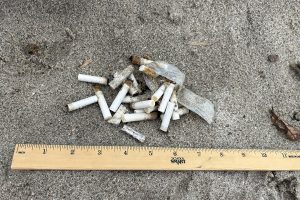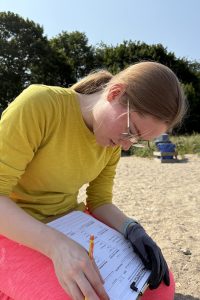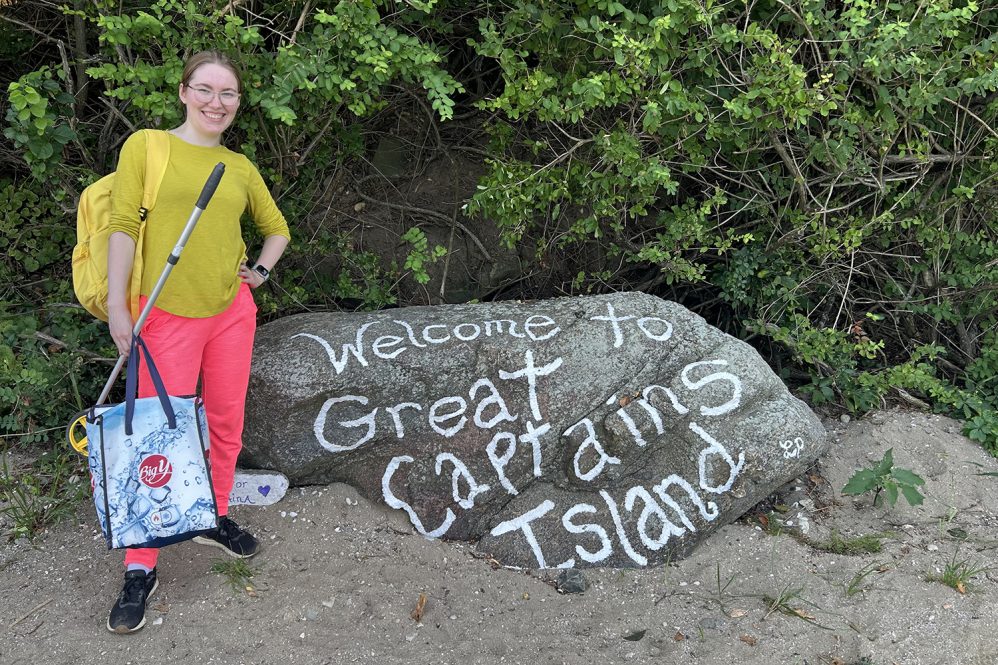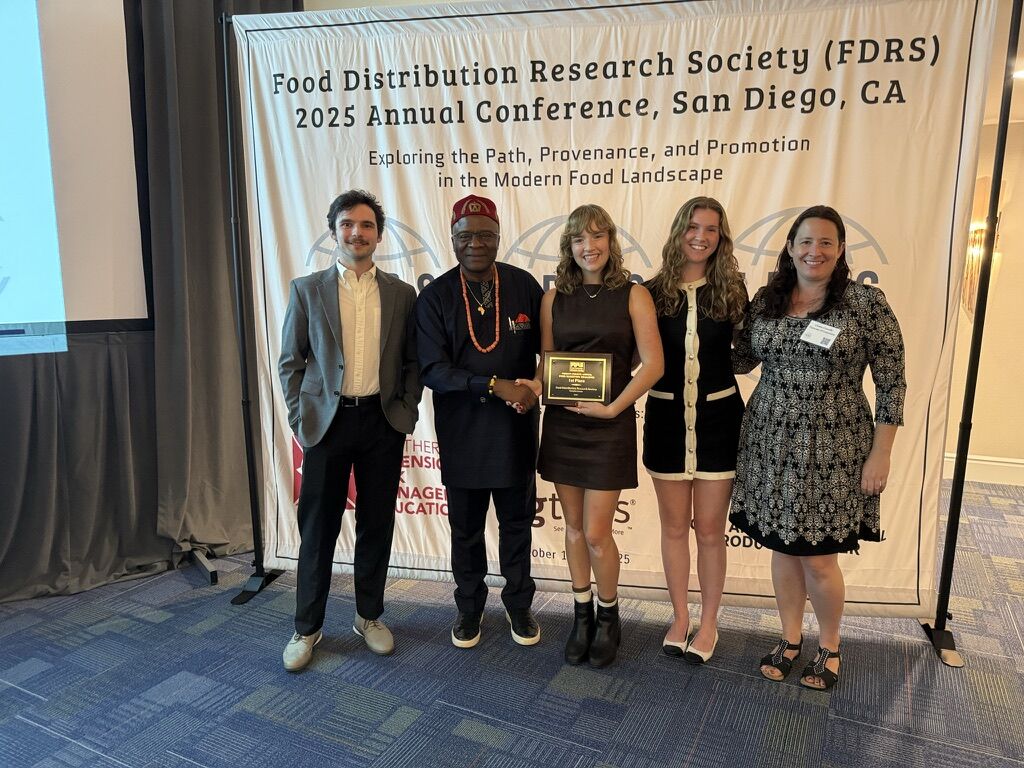Each year, the University of Connecticut opens its application process for the Summer Undergraduate Research Fund (SURF) Awards, which support students in summer research or creative projects. Among 46 undergraduate recipients for 2025 was the Neag School of Education’s Hiis LaRose ’26 (ED), ’26 (CLAS), ’27 MA with their project “A Sociohistorical Look at Connecticut Marine Debris.”
LaRose focused on cleaning public beaches in Connecticut and assessing the debris. They would mark a 100-meter section of a beach, then, in four random 5-meter transects along the site, they would collect any litter, noting the type and quantity of debris.
Through the National Oceanic and Atmospheric Administration’s Marine Debris Monitoring and Assessment Project (MDMAP), LaRose was able to log the waste into a standardized collection system, which can further detect differences in marine debris over time. The goal of MDMAP is to inspire prevention efforts and inform education and outreach.
“I originally did this in Puerto Rico over the winter with one of UConn’s Alternative Breaks, and I was really inspired by it because I realized this was something I could easily do back home,” LaRose says. “I could help beautify my communities and learn more about the debris along the Long Island Sound, which was something that the State of Connecticut talked about doing, but never truly started.”
I originally did this in Puerto Rico over the winter with one of UConn’s Alternative Breaks, and I was really inspired by it because I realized this was something I could easily do back home. — Hiis LaRose
SURF awards are available to students in all majors across all UConn campuses. Proposals are reviewed by a faculty committee representing various schools and colleges, and recipients are chosen through a competitive process. Beginning in summer 2025, the maximum amount awarded was increased to $5,500, which includes a $5,000 stipend and up to $500 for research consumables.
LaRose, who is majoring in history, sociology, and secondary history/social studies education, previously worked with assistant professor Mars Plater from the Department of History, who later became the faculty mentor for this project.
“Last summer, Hiis helped me finish a draft of my book manuscript through a Social Sciences, Humanities, and Arts Research Experience (SHARE) apprenticeship,” Plater says. “I was truly astounded by the depth and thoughtfulness of their suggestions, along with their research skills as they tracked down answers to questions that had been stumping me for years. I jumped at the chance to work with Hiis again, to support their own project after receiving so much help on mine.”
LaRose will go on to make a digital magazine highlighting their findings and what that means for Connecticut. These insights highlight how conversations about beaches and beach debris intersect with issues of beach privatization, state policies, and corporate influence. LaRose’s ultimate goal is to encourage people to think more critically about their communities.

“I haven’t found a ton of debris, which is great news,” LaRose says. “However, I have noticed a lot of cigarettes, which I think could be interesting to talk about, such as building some sort of infrastructure for people to dispose of that debris specifically, especially given how stigmatized smoking can be. It’s legal, but it’s not something we like talking about, and it seems logical to people that if you’re going to smoke at the beach, you just throw it in the sand.”
Seemingly small and unimportant, these cigarette butts can have a devastating impact on wildlife. The microplastics and toxins, when ingested by seagulls and other animals, can be poisonous. This is why LaRose proposes that the Connecticut government come up with proactive solutions for disposing of this debris.
Rather than publish their findings in a traditional academic paper, LaRose chose to create a digital magazine as a more accessible resource for the general public. After surveying 46 beaches in the state, their magazine will feature the “Who and What of Connecticut’s Beaches.”
LaRose defines a good beach as one that is free and public, well-maintained with regular cleanings, and cherished by its community. The top three beaches they highlighted were Williams Beach, Bluff Point State Park, and Rocky Neck State Park. Beaches identified as needing improvement included Greenwich Point Park, Penfield Beach, and Hammonasset State Park.
“Their work reveals not just fascinating trends in shoreline maintenance, but also significant barriers to the public’s access to the sea. Parking fees and permit policies are tools of exclusion that Hiis experienced firsthand while trying to clean up the beaches,” Plater says. “Hiis’ dedication and tenacity, though, ensured their successful completion of the project. I can’t wait to see Hiis share what they’ve learned with the UConn community and beyond.”
LaRose also shared their gratitude for Emily Rose Schwab, director and advisor for UConn’s BOLD Women’s Leadership Network, whose guidance and encouragement made a huge difference in bringing the project proposal to life.

“I was honestly shocked when I got it,” LaRose says. “I knew I wanted to do this project no matter what, but I also knew that I wouldn’t be able to if I didn’t receive any funding for it. It cost me a ridiculous amount of money just to get to the beaches, never mind gas prices and food. It’s great to see that people are willing to fund my silly little project where I’m not 100% [sure] what I’m doing all the time.”
However, this project did not come without challenges. LaRose shares that they encountered inconsistent treatment while conducting their research.
“I’ve noticed on certain beaches, especially those that cost money, I was treated with a lot of scorn,” they say. “It seemed like people were angry that I was there picking up debris. As opposed to beaches that were free and public, a lot of people were happy about that. It was enlightening, as I’ve never really had anyone be upset with me for cleaning up trash.”
LaRose points out that community service is often burdened by a societal stigma, since it is frequently viewed as a form of punishment rather than an opportunity. They suggest that one way to challenge this stereotype is by teaching students about the impact they can make.
“I think it’s very important to learn about citizen science,” they say. “I feel like there’s a really high barrier to entry for science that we don’t talk about very much in academia, how hard it is, and how scary it is for people who want to do these things but feel like they require a degree. And I, as someone who is not science-oriented, said, ‘let me prove that it’s not all that bad and that other people can do it.’ ”
Even though they will be teaching history and social studies after graduation, LaRose ultimately wants their students to understand how interdisciplinary life can be. This is especially important as younger generations become increasingly aware of the threats posed against the environment.
“Being able to do things that make a difference, even if it’s a small difference, is empowering,” LaRose says. “That is what I want to show to my future students.”



